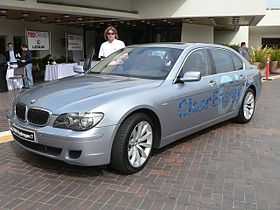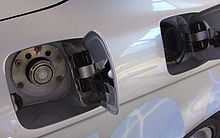BMW Hydrogen 7
| BMW Hydrogen 7 | |
|---|---|
 | |
| Overview | |
| Manufacturer | BMW |
| Body and chassis | |
| Class | Luxury car |
| Related | BMW 7 Series |
| Powertrain | |
| Engine | internal combustion engine |
The BMW Hydrogen 7 is a limited production hydrogen vehicle built from 2005-2007[1] by German automobile manufacturer BMW. The car is based on BMW’s traditional gasoline powered BMW 7 Series (E65) line of vehicles, and more specifically the 760Li. It uses the same 6 litre V-12 motor as does the 760i and 760Li; however, it has been modified to also allow for the combustion of hydrogen as well as gasoline, making it a bivalent engine. Unlike many other current hydrogen powered vehicles like those being produced by Honda, General Motors, and Daimler AG - which use fuel cell technology and hydrogen to produce electricity to power the vehicle - the BMW Hydrogen 7 burns the hydrogen in an internal combustion engine.
Production
BMW claims the Hydrogen 7 is the “world’s first production-ready hydrogen vehicle”; thus far, the Hydrogen 7 has only been released to select high-profile leasees. Only 100 total vehicles have been produced to put their technology to the test, and no more are planned to be produced.[2] BMW says it chose public figures such as politicians, media figures, businessmen and big names in the entertainment industry such as 2007 Academy Award-winning director Florian Henckel von Donnersmarck and the chairman of Sixt AG, Erich Sixt, because “they would be ideal ambassadors” for hydrogen fuel and can help spread awareness of the need for such technologies.[3]
There is doubt, however, over whether or not this automobile will ever be put into larger production, even if hydrogen fuel technology reaches the point of economical and “green” feasibility, as well as to have the infrastructure required to put hydrogen vehicles in demand. The Hydrogen 7 uses more fuel than many trucks, consuming 13.9 L/100 km for gasoline (petrol) and 50 L/100 km for hydrogen. The following table shows the consumption (L/100 km) and fuel economy (mpg) for both Imperial and US gallons.
| Gasoline (petrol) | Hydrogen | ||||
|---|---|---|---|---|---|
| L/100 km | Imp. mpg | US mpg | L/100 km | Imp. mpg | US mpg |
| 13.9 | 20.3 | 16.9 | 50.0 | 5.6 | 4.7 |
The difference in fuel consumption is largely due to the different energy density with gasoline (petrol) yielding 34.6 MJ/L and liquid hydrogen yielding 10.1 MJ/L. Based on these energy density figures, one would expect 47.6 L/100 km for hydrogen based on 13.9 L/100 km for gasoline (petrol); which is very close to the stated 50.0 L/100 km. Using hydrogen in an internal combustion engine as a source of energy is far less efficient than fuel cell technologies; however, this is a system that is in production (albeit limited) now.
Nonetheless, hydrogen fuel (whether converted to energy in fuel cells or burned in an internal combustion engines) is not as green as it may seem; particularly so when you also consider that producing liquid hydrogen requires vast amounts of energy.[4] (Unless however, the energy to produce the hydrogen is obtained through renewable sources, like solar or wind and subsequent electrolyzation is the method of production). It will also only be more expensive than its sister the 760Li (no retail price has been announced), which is BMW’s biggest and most expensive sedan, with a base price tag of over $118,000, thus further diminishing its widespread appeal. As of November, 2006, there were only five filling stations in the entire world that supported BMW’s filling technology, furthering the obstacles to making this car usable.
Use of hydrogen technology

The BMW Hydrogen 7 burns hydrogen in an internal combustion engine (ICE). When in hydrogen mode, high-pressure injectors, designed by HOERBIGER ValveTec GmbH, directly inject hydrogen gas into the cylinder combustion chamber with pressures of up to 300 bar, (4500 psi). The combustion technique is a combination of spark-ignition and diesel combustion systems using surface ignition, subsequently followed by a diffusion type of combustion. This combustion system matches the efficiency values of the currently best turbodiesel engines at a maximum of 42 percent.[5] The car can also switch seamlessly between hydrogen and gasoline at the touch of a button on the steering wheel, and will do so automatically when one of the fuels is depleted.
The hydrogen fuel is stored in a large, nearly 170 litre (45 gallon),[6] bi-layered and highly insulated tank that stores the fuel as liquid rather than as compressed gas, which BMW says offers 75% more energy per volume as a liquid than compressed gas at 700 bars of pressure.[7] The hydrogen tank’s insulation is under high vacuum in order to keep heat transfer to the hydrogen to a bare minimum, and is purportedly equivalent to a 17-metre (56 ft) thick wall of polystyrene Styrofoam.[8]
To stay a liquid, hydrogen must be super-cooled and maintained at cryogenic temperatures of, at warmest, −253 °C (−423.4 °F). When not using fuel, the Hydrogen 7’s hydrogen tank starts to warm and the hydrogen starts to vaporize. Once the tank’s internal pressure reaches 87 psi, at roughly 17 hours of non-use, the tank will safely vent the building pressure. Over 10–12 days, it will completely lose the contents of the tank because of this.[9]
Specifications
The car is powered by a 6.0 litre V12 engine capable of running on both premium gasoline and hydrogen fuel. It is rated at 191-kilowatt (260 PS; 256 hp) and 390 N·m (290 lb·ft) of torque using either fuel.[4] The car accelerates from stopped to 100 km/h (62 mph) in 9.5 seconds. The hydrogen fuel tank holds roughly 8 kg (18 lb) of hydrogen, enough to travel 201 kilometres (125 mi). The gasoline fuel tank holds 73.8 litres, enough to travel 480 kilometres (300 mi) for a combined total of over 640 kilometres (400 mi) at cruising speeds. The Hydrogen 7 gets about 50 L/100 km (5.6 mpg-imp; 4.7 mpg-US) on hydrogen. In comparison, Honda's FCX Clarity gets about 15 L/100 km (19 mpg-imp; 16 mpg-US) liquid hydrogen equivalent mileage. The curb weight of the Hydrogen 7 is roughly 250 kilograms (550 lb) heavier than the 760Li, bringing it to about 2,300 kilograms (5,100 lb).[10]
See also
Notes
- ↑ BMW Model Archive - List of E-Codes
- ↑ BMW EfficientDynamics : BMW CleanEnergy : BMW AG
- ↑ Coming soon: Hydrogen-powered BMW
- ↑ 4.0 4.1 BMW's Hydrogen 7: Not as Green as it Seems
- ↑ BMW HYDROGEN ENGINE REACHES TOP LEVEL EFFICIENCY
- ↑ Wallner T, Lohse-Busch H, Korn T, et al. Fuel economy and emissions evaluation of BMW Hydrogen 7 Mono-Fuel demonstration vehicles. International Journal Of Hydrogen Energy [serial online]. December 15, 2008;33(24):7607-7618. Available from: Academic Search Premier, Ipswich, MA. Accessed February 10, 2012.
- ↑ Road Testing BMW's Hydrogen 7
- ↑ BMW Hydrogen 7 Prototype concept car from the Los Angeles Auto Show
- ↑ Road Testing BMW's Hydrogen 7
- ↑ Road Testing BMW's Hydrogen 7
External links
| Wikimedia Commons has media related to BMW Hydrogen 7. |